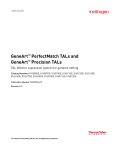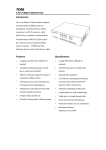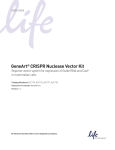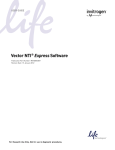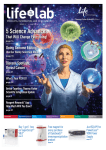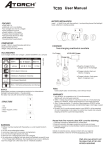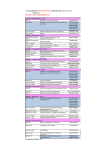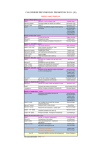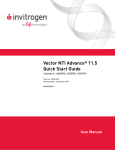Download GeneArt® TAL User Manual - Thermo Fisher Scientific
Transcript
user guide GeneArt® PerfectMatch TALs and GeneArt® Precision TALs TAL effector expression system for genome editing Catalog Numbers 816508DE. 816509DE, 816510DE, 816511DE, 816512DE, 816514DE, 816516DE, 816517DE, 816518DE, 816519DE, 816010DE, 816011DE Publication Number MAN0006670 Revision A.0 For Research Use Only. Not for use in diagnostic procedures. Information in this document is subject to change without notice. DISCLAIMER LIFE TECHNOLOGIES CORPORATION AND/OR ITS AFFILIATE(S) DISCLAIM ALL WARRANTIES WITH RESPECT TO THIS DOCUMENT, EXPRESSED OR IMPLIED, INCLUDING BUT NOT LIMITED TO THOSE OF MERCHANTABILITY, FITNESS FOR A PARTICULAR PURPOSE, OR NON-INFRINGEMENT. TO THE EXTENT ALLOWED BY LAW, IN NO EVENT SHALL LIFE TECHNOLOGIES AND/OR ITS AFFILIATE(S) BE LIABLE, WHETHER IN CONTRACT, TORT, WARRANTY, OR UNDER ANY STATUTE OR ON ANY OTHER BASIS FOR SPECIAL, INCIDENTAL, INDIRECT, PUNITIVE, MULTIPLE OR CONSEQUENTIAL DAMAGES IN CONNECTION WITH OR ARISING FROM THIS DOCUMENT, INCLUDING BUT NOT LIMITED TO THE USE THEREOF. Limited Use Label License No. 406: GeneArt® Precision TAL Effector Products: The purchase of this product conveys to the buyer limited, non-transferable rights under certain TAL Effector technology owned by inventors from MartinLuther-Universitat Halle-Wittenberg and licensed to Life Technologies Corporation to use this product and components of this product only to perform internal research for the sole benefit of the buyer. The buyer may also use standard molecular biology techniques to make additional copies of this product for purposes of internal research for the sole benefit of the buyer but the buyer may not modify the sequence of the TAL Effector within this product. Any buyer that is a for-profit entity may not use this product, its components or materials or cells made using this product or its components to generate any animal without first obtaining additional rights from Life Technologies. The buyer cannot sell or otherwise transfer (a) this product, (b) its components, or (c) materials, cells, or organisms made using this product or its components (including but not limited to Plants in all cases hereunder) to a third party, or otherwise use this product, its components, or materials, cells, or organisms made using this product or its components for any Commercial Purpose or Development Purpose with the sole exception that buyer may transfer this product, its components, and/or materials, cells, or organisms made using this product or its components to (i) the buyer’s legal affiliates and/or (ii) a scientific collaborator, provided that each such legal affiliate and/or, scientific collaborator agrees in writing (1) not to transfer such product, its components, or materials, cells, or organisms made using such product or its components to any third party, and (2) to use such product, its components, and materials, cells, and organisms made using such product and/or its components solely for research as set forth in this limited use label license and not for Commercial Purposes or Development Purposes. If this product is subject to multiple limited use label licenses, the terms of the most restrictive limited use label license shall control. Mice generated using this product may be donated to The Jackson Laboratory by not-for-profit buyers, and by forprofit buyers who have obtained the additional rights noted in the preceding paragraph. Please include a copy of this limited use label license with all donations to identify the TAL Effector technology used. “Commercial Purpose” means any activity for consideration, including but not limited to: (a) any use, directly or indirectly, in manufacturing, production, production of biomolecules or quality control; (b) any use to provide a service, information, or data for consideration; (c) any use for therapeutic, diagnostic or prophylactic purposes; or (d) any sale, resale, leasing, or licensing, whether or not for research purposes. “Development Purpose” means any: (a) clinical activity following IND-enabling preclinical toxicological studies or equivalents thereof; (b) activity in any agricultural field trial, including any such field trial that would be subject to regulation by the United States Department of Agriculture if the plants were to constitute genetically engineered organisms under 7 C.F.R. § 340 (or any successor regulation); (c) activity directed towards the submission of data to the United States Department of Agriculture, or any equivalent regulatory agency outside of the United States, in support of an application for clearance, approval or deregulation by such agency; (d) screening or profiling of more than 10,000 distinct compounds (high-throughput screening); and/or (e) scale-up activities, the primary focus of which is to increase from small-scale to production-scale. “Plant” means any eukaryotic plants, plant tissues or plant cells, including green algae, belonging to the plant kingdom defined as Viridiplantae, including any progeny (propagated through any number of generations) or unmodified derivatives of such plants, tissues or cells. For clarity, fungi or blue-green algae are specifically excluded from this definition. For information on obtaining additional rights to TAL Effector technology for any use not permitted herein, except use in Plants, please contact Life Technologies at [email protected]. For information on obtaining additional rights to TAL Effector technology for any use in Plants not permitted herein, please contact Two Blades Foundation at [email protected] or Two Blades Foundation, 1630 Chicago Avenue, Suite 1907, Evanston, IL 60201 USA. For information on donating mice to The Jackson Laboratory, please visit their website at: http://www.jax.org/grc/index.html. Limited Use Label License No. 521: GeneArt® Precision TALEN™ Products: The purchase of this product conveys to the buyer limited, non-transferable rights under certain TALEN™ technology owned and/or controlled by Cellectis SA (including patents owned by the University of Minnesota and Iowa State University) and licensed to Life Technologies Corporation to use this product and components of this product only to perform internal research for the sole benefit of the buyer. The buyer may also use standard molecular biology techniques to make additional copies of this product for purposes of internal research for the sole benefit of the buyer, except the buyer may not modify the sequence of the TAL effector within this TALEN™ product. Any buyer that is a for-profit entity may not use this product, its components or materials or cells made using this product or its components to generate any animal without first obtaining additional rights from Life Technologies. The buyer cannot sell or otherwise transfer (a) this product, (b) its components, or (c) materials, cells, or organisms made using this product or its components (including but not limited to Plants in all cases hereunder) to a third party, or otherwise use this product, its components, or materials, cells, or organisms made using this product or its components for any Commercial Purpose or Development Purpose with the sole exception that buyer may transfer this product, its components, and/or materials, cells, or organisms made using this product or its components to (i) the buyer’s legal affiliates and/or (ii) a scientific collaborator, provided that each such legal affiliate and/or scientific collaborator agrees in writing (1) not to transfer such product, its components, or materials, cells, or organisms made using such product or its components to any third party, and (2) to use such product, its components, and materials, cells, and organisms made using such product and/or its components solely for research as set forth in this limited use label license and not for Commercial Purposes or Development Purposes. If this product is subject to multiple limited use label licenses, the terms of the most restrictive limited use label license shall control. “Commercial Purpose” means any activity for consideration, including but not limited to: (a) any use, directly or indirectly, in manufacturing, production, production of biomolecules, or quality control; (b) any use to provide a service, information, or data for consideration (c) any use for therapeutic, diagnostic or prophylactic purposes; or (d) any sale, resale, leasing, or licensing, whether or not for research purposes. “Development Purpose” means any: (a) clinical activity following IND-enabling preclinical toxicological studies or equivalents thereof; (b) activity in any agricultural field trial, including any such field trial that would be subject to regulation by the United States Department of Agriculture if the plants were to constitute genetically engineered organisms under 7 C.F.R. § 340 (or any successor regulation); (c) activity directed towards the submission of data generated using a Plant to the United States Department of Agriculture, or any equivalent regulatory agency outside of the United States, in support of an application for clearance, approval or deregulation by such agency; (d) screening or profiling of more than 10,000 distinct compounds (high-throughput screening); e) scale-up activities, the primary focus of which is to increase from small-scale to production-scale and/or (g) any use of pigs, cattle or sheep cells or pig, cattle, or sheep animals generated using this TALEN™ product for (i) agricultural food applications, or (ii) animal models and biomaterials models used for research and development of therapeutic compounds or protocols, and production of non-cellular products or proteins for therapeutic, cosmetic or neutraceutical applications. “Plant” means any eukaryotic plants, plant tissues or plant cells, including green algae, belonging to the plant kingdom defined as Viridiplantae, including any progeny (propagated through any number of generations) or unmodified derivatives of such plants, tissues or cells. For clarity, fungi or blue-green algae are specifically excluded from this definition. For information on obtaining rights to TALEN™ technology for any use not permitted herein, except use in the therapeutic field and in Plants, please contact Life Technologies at [email protected]. For information on obtaining rights to TALEN™ technology for any use in the therapeutic field, please contact Cellectis SA at [email protected]. For information on obtaining rights to TALEN™ technology for any use in Plants not permitted herein, please contact Cellectis Plant Sciences, Inc. at [email protected]. © 2014 Thermo Fisher Scientific Inc. All rights reserved. All trademarks are the property of Thermo Fisher Scientific and its subsidiaries unless otherwise specified. TALEN is a trademark of Cellectis. Contents Contents and storage ...................................................................................................................................... 1 Introduction ......................................................................................................................................2 Product information ........................................................................................................................................ 2 Methods ............................................................................................................................................6 Experimental outline....................................................................................................................................... 6 Create a TAL sequence ................................................................................................................................... 7 Create an expression clone ............................................................................................................................ 9 Perform the LR recombination reaction...................................................................................................... 11 Transform competent E. coli cells ............................................................................................................... 13 Analyze transformants ................................................................................................................................. 14 Transfection................................................................................................................................................... 15 Appendix ......................................................................................................................................... 16 Map of N-TAL FokI Entry Vector................................................................................................................... 16 Map of N-TAL FokI CMV Expression Vector ................................................................................................ 17 Features of GeneArt® PerfectMatch TAL vectors ....................................................................................... 18 Map of TAL FokI Entry Vector ....................................................................................................................... 19 Map of TAL vp16 Entry Vector....................................................................................................................... 20 Map of TAL vp64 Entry Vector....................................................................................................................... 21 Multiple cloning site of TAL MCS Entry Vector ............................................................................................ 24 Features of GeneArt® Precision TALs entry vectors ................................................................................... 25 Map of pENTR™-gus entry vector ................................................................................................................. 26 Accessory products ....................................................................................................................................... 27 Technical support.......................................................................................................................................... 28 References .................................................................................................................................................... 29 Contents and storage Ordering information GeneArt® PerfectMatch TALs functional domain Catalog no. Truncated N-TAL FokI 816508DE Truncated N-TAL FokI CMV 816509DE GeneArt® Precision TALs functional domain Catalog no. Native TAL FokI 816510DE Truncated TAL FokI 816511DE Native TAL vp16 activator 816512DE Native TAL vp64 activator 816514DE Native TAL MCS 816516DE Truncated TAL MCS 816517DE Native TAL KRAB repressor 816518DE Truncated TAL KRAB repressor 816519DE DNA binding domain Catalog no. 18 Nucleotide Binding Domain (containing your specific TAL) 816010DE 24 Nucleotide Binding Domain (containing your specific TAL) 816011DE Contents 5 μg of vector DNA, lyophilized. The TAL vector contains a functional domain and an 18 or 24 nucleotide DNA binding domain. Shipping/storage All GeneArt® PerfectMatch TALs and GeneArt® Precision TALs are shipped at room temperature. Do not store lyophilized DNA for a prolonged time. Upon receipt, resuspend the vector and store at –20°C. Resuspend the vector DNA Add 50 µL of distilled water or 10 mM Tris-HCl (pH 8.0) to the tube containing the vector and incubate for one hour at room temperature. Resuspend the vector DNA by gently pipetting up and down 5–10 times. Store the resuspended vector DNA at –20°C. Antibiotic resistance markers are indicated on each tube label. The standard delivery amount of DNA is 5 µg. GeneArt® PerfectMatch TALs and GeneArt® Precision TALs 1 Introduction Product information Introduction GeneArt® PerfectMatch TALs and GeneArt® Precision TALs are optimized to deliver transcriptional effectors to cells in a sequence specific manner. These TALs are provided as Gateway® -adapted entry vectors. The sequence is transferred from the entry vector to a destination vector by LR recombination, resulting in high-level expression of the TAL effectors. The GeneArt® PerfectMatch TALs are also provided as a CMV expression vector, for high-level expression in mammalian cells without an LR recombination step. TAL effectors Transcription activator-like (TAL) effector proteins are naturally occurring transcriptional activators secreted by Xanthamonas spp. into their plant hosts. They are injected into plant host cells via a Type III secretion system and travel to the nucleus where they bind to, and activate specific promoter sequences that lead to changes that are permissive for bacterial infection (Boch and Bonas, 2010). TAL effector proteins consist of constant N and C terminal domains (containing translocation and nuclear localization/activation signals respectively) flanking a central repeat domain. Each repeat is 34–35 amino acids in length, with two centrally located residues that make up a repeat variable domain (RVD) that dictates the affinity of the repeat for different nucleotide targets. Combination and order of various repeat types define the genomic target site specificity of a particular TAL effector. The deciphering of this TAL effector ‘code’ led to the engineering of designer TAL effector proteins that function as a vehicle to target functionality of essentially any open region of the chromosomes of plants, bacteria, yeast, flies and mammalian cells (Boch et al., 2009; Moscou and Bogdanove, 2009). Activities such as activators, repressors and nucleases have been demonstrated to be addressable via this powerful system (Li et al., 2011; Scholze and Boch, 2011; Mussolino and Cathomen, 2012). These tools have applications from efficient genomic editing and gene knock out for manipulating the chromosome to modulation of specific promoter activities to allow simple and complex metabolic manipulation in various species of cells. GeneArt® PerfectMatch TALs and GeneArt® Precision TALs The two versions of TALs available are: GeneArt® PerfectMatch TALs and GeneArt® Precision TALs. With GeneArt® PerfectMatch TALs and GeneArt® Precision TALs the researcher can determine the exact DNA loci they would like to have their functionality delivered to and have specific TAL genes built to perform the function. The researcher will receive a Gateway®-adapted entry vector containing the coding sequence for a TAL nuclease or activator designed to bind a specific 18 or 24 base DNA sequence of choice. The GeneArt® PerfectMatch TALs are also available in a CMV expression vector. 2 GeneArt® PerfectMatch TALs and GeneArt® Precision TALs GeneArt® PerfectMatch TALs GeneArt® PerfectMatch TALs can be designed to target any locus in the genome since there are no restrictions for the 5' base. Previously, target sites for customized TAL effectors required a 5’ T in the target sequences for maximal binding activities. The 5’ T constraint limited the flexibility of TAL effector target sites in the genome and prevented some specific sites in the genome from being targeted. Structure studies suggested the N-terminal domain (NTD) of the TAL effectors, not the central repeat domain, is responsible for the interaction with the 5’ T of the target. We developed our second generation TALs, GeneArt® PerfectMatch TALs, by mutating the N-terminal domain to reduce its specificity for 5’ T. GeneArt® PerfectMatch TALs can target DNA sequences with any 5’ base (T, G, C or A) with performance comparable to that of GeneArt® Precision TALs. N-TAL FokI and N-TAL FokI CMV GeneArt® PerfectMatch TALs contain a truncated TAL engineered with FokI nuclease. The FokI TAL nuclease pair binds to duplex DNA at the target sites designated by the DNA binding domains to cleave the DNA. There are two versions of GeneArt® PerfectMatch TALs: • N-TAL FokI: a Gateway® -adapted entry vector which allows easy transfer through a LR recombination reaction to destination vectors designed to facilitate high-level expression of the TAL effectors in your cells of choice. • N-TAL FokI CMV: a CMV expression vector which contains a CMV promoter to drive high-level expression of the TAL in mammalian systems. It can be directly used without extra subcloning. GeneArt® PerfectMatch TALs and GeneArt® Precision TALs 3 GeneArt® Precision TALs Unlike GeneArt® PerfectMatch TALs, Precision TALs have a conserved T binding motif at the N-terminus of the TAL effector protein and so require a 5' T for maximal binding activity. GeneArt® Precision TALs are available as the following Gateway®-adapted entry vectors: TAL FokI, TAL VP16, TAL VP64, TAL KRAB, and TAL MCS. TAL FokI GeneArt® Precision TALs engineered with the FokI nuclease can be used for targeting specific genes for silencing. FokI is a type IIS restriction endonuclease from Flavobacterium okeanokoites, consisting of an N-terminal DNA-binding domain and a non-specific DNA cleavage domain at the C-terminal. A FokI nuclease pair binds to duplex DNA at the target sites designated by the DNA binding domains to cleave the DNA. TAL VP16 and TAL VP64 GeneArt® Precision TALs engineered with the VP16 or VP64 activators can be used to increase the expression level of endogenous or recombinant genes. VP16 is a trans-acting protein originating from the herpes simplex virus that forms a complex with host transcription factors to induce immediate early gene transcription. VP64 is a tetrameric form of the VP16 minimal activation domain. TAL KRAB GeneArt® Precision TALs engineered with the KRAB repressor can be used to down-regulate the expression level of endogenous or recombinant genes. 4 GeneArt® PerfectMatch TALs and GeneArt® Precision TALs TAL MCS GeneArt® Precision TALs that include a multiple cloning site (MCS) allow the user to clone any desired effector domain, and target the protein to any locus within the genome. The Gateway® Technology The Gateway® Technology is a cloning method based on the bacteriophage lambda site-specific recombination system which facilitates the integration of lambda into the E. coli chromosome and the switch between the lytic and lysogenic pathways (Ptashne, 1992). In Gateway® Technology, the components of the lambda recombination system are modified to improve the specificity and efficiency of the system (Bushman et al., 1985). LR recombination reaction An LR recombination reaction is performed between the entry clone and the destination vector of choice to generate an expression clone. The LR recombination reaction is mediated by LR Clonase® II Enzyme Mix, a mixture of the bacteriophage λ Integrase (Int) and Excisionase (Xis) proteins, and the E. coli Integration Host Factor (IHF) protein. GeneArt® PerfectMatch TALs and GeneArt® Precision TALs 5 Methods Experimental outline Experimental outline steps The table below outlines the steps required to express your GeneArt® PerfectMatch TALs and GeneArt® Precision TALs in cells. Step Action Page 1 Determine the sequence of the binding site for your TAL effector protein. 7 2 Synthesize TAL sequence and clone into a Gateway® adapted entry vector of choice to generate an entry clone. Or, clone TAL sequence into the CMV expression vector — 3 Perform an LR recombination reaction by mixing the entry clone and the appropriate destination vector with Gateway® LR Clonase® II Enzyme Mix. 11 Note: This step is not required with the CMV vector. 6 4 Transform the recombination reaction into competent E. coli cells and select for expression clones. 13 5 Analyze transformants for the presence of insert by restriction enzyme digestion or colony PCR. 14 6 Prepare purified plasmid DNA and transfect the cell line of choice. 15 GeneArt® PerfectMatch TALs and GeneArt® Precision TALs Create a TAL sequence GeneArt® PerfectMatch TALs binding site rules The following are guidelines and rules for generating the PerfectMatch TAL sequence: • The GeneArt® PerfectMatch TALs offering allows the construction of TAL effector functional proteins directed to either 18 or 24 base DNA target sites. • GeneArt® PerfectMatch TALs are provided in two types of vectors: 1) Gateway®-adapted entry vector: Gateway®-adapted entry vectors allow easy transfer of target specific TAL domain through a LR recombination reaction into destination vectors designed to facilitate high-level expression of the TAL effectors in your cell line of choice. A Gateway®-adapted destination vector is needed for expression plasmid generation. Choose a destination vector from our Gateway®-adapted vector portfolio. 2) CMV expression vector (mammalian expression vector): The mammalian expression vector contains CMV promoter which drives high-level expression of the TAL in mammalian systems. PerfectMatch TALs provided in this vector can be directly used for expression in mammalian systems without the need for any intermediate sub-cloning steps. Optional: PerfectMatch TAL cassette can be transferred directly into your expression vector of choice with the restriction enzymes Not I and Hind III. • Each target site sequence is preceded by a 5’ N. PerfectMatch TAL protein allows binding to a DNA sequence preceded by any DNA base. The letter N represents any base of A, G, C or T. The 5’ N does not count as one of the 18 or 24 bases to be selected for targeting your specific site. • Design nuclease pairs with a spacing of 13–18 bp between the target sites on opposite strands of the DNA. However, we recommend a spacing of 15–16 bp between the target sites in order to achieve maximal nuclease activity. The target sites can be either 18 or 24 bp in length. Use the following image as a reference for the orientation of the binding domains. • The contribution of individual binding motifs within the DNA binding domain to TAL effector binding efficiency is thought to differ, since strong and weak binding motifs exist. The A and T binding motifs are thought to fall within the “weak binder” category, while the C and G binding motifs are thought to be “strong binders”. Stretches of more than 5 weak binders should be avoided at the extreme 5’ end of the binding domain (not counting the 5’ N), or if they are not flanked by Cs. It is recommended to select a TAL effector with a DNA binding domain composed of mixed GeneArt® PerfectMatch TALs and GeneArt® Precision TALs 7 binding motifs for best results. • GeneArt® Precision TALs binding site rules 8 In the context of the living cell, DNA accessibility also determines TAL effector efficiency. Chromatin structure, DNA methylation, and/or proteins bound to the DNA may interfere with TAL binding. The following are guidelines and rules for generating the Precision TAL sequence: • The GeneArt® Precision TALs offering allows the construction of TAL effector functional proteins directed to either 18 or 24 base DNA target sites. • Each target site must be preceded by a 5’ T because the N-terminus of the TAL effector protein contains a conserved T binding motif. The 5’ T does not count as one of the 18 or 24 bases to be selected for targeting your specific site. • Nuclease pairs need to be designed with a spacing of 13–18 bp between the target sites on opposite strands of the DNA. Both target sites must be preceded by a 5’ T. The target sites can be either 18 or 24 bp in length. The following image should be used as a reference for the orientation of the binding domains. • The contribution of individual binding motifs within the DNA binding domain to TAL effector binding efficiency is thought to differ, since strong and weak binding motifs exist. The A and T binding motifs are thought to fall within the “weak binder” category, while the C and G binding motifs are thought to be “strong binders”. Stretches of more than 5 weak binders should be avoided at the extreme 5’ end of the binding domain (not counting the 5’ T), or if they are not flanked by Cs. It is recommended to select a TAL effector with a DNA binding domain composed of mixed binding motifs for best results. • In the context of the living cell, DNA accessibility also determines TAL effector efficiency. It is possible that chromatin, DNA methylation, and/or proteins bound to the DNA may interfere with TAL binding. • Although promoter structure varies, and specific rules regarding design are currently lacking, it is recommended that TAL transcription factors used for transcriptional activation of natural promoters be positioned upstream of the TATA box, or in some cases downstream of the transcriptional start site. Selecting a target site directly over the TATA box, or other known transcription factor binding site is not recommended. Be sure that the natural ATG is present, and that no premature ATG which may interfere with the natural translational start is transcribed. GeneArt® PerfectMatch TALs and GeneArt® Precision TALs Create an expression clone Introduction To create an expression clone, perform the LR recombination reaction to transfer the gene of interest from the Gateway® -adapted entry vector into your destination vector of choice. We recommend that you review this section and the next section entitled Perform the LR recombination reaction (pages 11–12) before proceeding. Note: This step is not required when using the GeneArt® PerfectMatch TALN-TAL FokI CMV. Resuspend the vectors Each destination vector is supplied as 6 µg of lyophilized plasmid. To use, resuspend the destination plasmid in 40 µL of TE Buffer, pH 8.0 to a final concentration of 150 ng/µL. Note: Destination vectors are supplied as supercoiled plasmids. The linearization of the destination vector is NOT required to obtain optimal results for any downstream application. Propagate the vectors Entry clone Propagate and maintain your entry clone using a recA, endA E. coli strains like TOP10, TOP10F’, DH5α, JM109, or equivalent for transformation. Select transformants on LB plates containing 50–100 µg/mL kanamycin. Prepare a glycerol stock of each plasmid for long-term storage. Destination vector If you wish to propagate and maintain your destination vectors prior to recombination, we recommend using One Shot® ccdB Survival T1R Chemically Competent E. coli (Cat. no. C7510-03) for transformation. The One Shot® ccdB Survival T1R E. coli strain is resistant to the toxic effects of the ccdB gene and can support the propagation of plasmids containing the ccdB gene. To maintain the integrity of the vector, select for transformants in media containing 50–100 µg/mL ampicillin and 15–30 µg/mL chloramphenicol. IMPORTANT! Do NOT use general E. coli cloning strains including TOP10 or DH5α for propagation and maintenance of destination vectors as these strains are sensitive to the toxic effects of the ccdB gene. GeneArt® PerfectMatch TALs and GeneArt® Precision TALs 9 Create an expression clone, continued Gateway® recombination reactions The LR reaction facilitates recombination of an attL substrate (entry clone) with an attR substrate (destination vector) to create an attB-containing expression clone (see diagram below). This reaction is catalyzed by LR Clonase® II Enzyme Mix. Recombination region of the expression clone In the following example, the recombination region of the expression clone resulting from the LR reaction between a TAL entry clone and the Gateway® pcDNA™-DEST40 destination vector sequence is shown. Features of the recombination region: • Shaded regions correspond to those DNA sequences transferred from the entry clone into the destination vector by recombination. • • 10 Non-shaded regions are derived from the destination vector. The underlined nucleotides flanking the shaded region correspond to bases 918 and 2601, respectively, of the Gateway® pcDNA™-DEST40 destination vector sequence. GeneArt® PerfectMatch TALs and GeneArt® Precision TALs Perform the LR recombination reaction Introduction Perform an LR recombination reaction between the entry clone and the appropriate destination vector. We recommend that you include a positive control (see below) and a negative control (no LR Clonase® II Enzyme Mix) in your experiment. Note: This step is not required when using the GeneArt® PerfectMatch TALN-TAL FokI CMV. Positive control The pENTR™-gus plasmid is used as a positive control for LR recombination and expression. Using the pENTR™-gus entry clone in an LR recombination reaction with a destination vector will allow you to generate an expression clone containing the gene encoding β-glucuronidase (gus). The pENTR™-gus positive control is supplied with the LR Clonase® II Enzyme Mix. LR Clonase® II Enzyme Mix The LR Clonase® II Enzyme Mix is available separately. The LR Clonase® II Enzyme Mix combines the proprietary enzyme formulation and 5X LR Clonase® Reaction Buffer (previously supplied as separate components in LR Clonase® Enzyme Mix) into a single-tube format. Use the protocol provided on page11 to perform the LR recombination reaction using LR Clonase® II Enzyme Mix. Note: You may perform the LR recombination reaction using LR Clonase® Enzyme Mix, if desired. To use LR Clonase® Enzyme Mix, follow the protocol provided with the product. Do not use the protocol for LR Clonase® II Enzyme Mix provided in this manual as reaction conditions differ. Materials needed You should have the following materials on hand before beginning: • Purified plasmid DNA of your entry clone (50–150 ng/µL in TE, pH 8.0) • Destination vector (150 ng/µL in TE, pH 8.0) • LR Clonase® II Enzyme Mix (Cat. no. 11791-020, 11791-100) • TE Buffer, pH 8.0 (10 mM Tris-HCl, pH 8.0, 1 mM EDTA) • Proteinase K solution (supplied with the LR Clonase® II Enzyme Mix) • pENTR™-gus positive control (supplied with the LR Clonase® II Enzyme Mix) GeneArt® PerfectMatch TALs and GeneArt® Precision TALs 11 Perform the LR recombination reaction, continued Set up the LR recombination reaction Follow this procedure to perform the LR reaction between your entry clone and the destination vector. If you want to include a negative control, set up a separate reaction but omit the LR Clonase® II Enzyme Mix. 1. Add the following components to 1.5 mL microcentrifuge tubes at room temperature and mix. Set up an additional set of reactions for your negative control. You will not add LR Clonase® II Enzyme Mix to these reactions Component Entry clone (50–150 ng/reaction) Destination vector (150 ng/µL) pENTR™-gus (50 ng/µL) TE Buffer, pH 8.0 Sample Positive control 1–7 µL — 1 µL 1 µL — 2 µL to 8 µL 5 µL 2. Remove the LR Clonase® II Enzyme Mix from –20°C and thaw on ice (~ 2 minutes). 3. Vortex the LR Clonase® II Enzyme Mix briefly twice (2 seconds each time). 4. Add 2 µL of LR Clonase® II Enzyme Mix to each sample or positive control reaction listed above. Mix well by pipetting up and down. Do not add LR Clonase® II Enzyme Mix to negative control reactions. Reminder: Return LR Clonase® II Enzyme Mix to –20°C immediately after use. 5. Incubate reactions at 25°C for 1 hour. Note: For most applications, 1 hour will yield a sufficient number of colonies for analysis. Depending on your needs, the length of the recombination reaction can be extended up to 18 hours. For large plasmids (≥10 kb), longer incubation times will yield more colonies. 6. Add 1 µL of Proteinase K solution to each reaction. Incubate for 10 minutes at 37°C. 7. Proceed to Transform competent E. coli cells, next page. Note: You may store the LR reaction at –20°C for up to 1 week before transformation, if desired. 12 GeneArt® PerfectMatch TALs and GeneArt® Precision TALs Transform competent E. coli cells Introduction Once you have performed the LR recombination reaction, transform chemically competent E. coli with the resulting expression clone. Materials needed You should have the following materials on hand before beginning: Transformation procedure • LR recombination reaction (from Step 7, previous page) • Chemically competent E. coli cells • S.O.C. Medium (warm to room temperature) • pUC19 control (use as a control for transformation if desired) • LB plates containing 100 µg/mL ampicillin (two for each transformation; warm at 37°C for 30 minutes) • 42°C water bath • 37°C shaking and non-shaking incubator 1. For each transformation, aliquot 50 µL of chemically competent E. coli cells into a sterile microcentrifuge tube. 2. Add 1 µL of the LR recombination reaction (from Set up the LR recombination reaction, Step 7, previous page) into the tube containing 50 µL of competent cells and mix gently. Do not mix by pipetting up and down. 3. Incubate on ice for 30 minutes. 4. Heat-shock the cells for 30 seconds at 42°C without shaking. 5. Immediately transfer the tubes to ice. 6. Add 450 µL of room temperature S.O.C. Medium. 7. Cap the tube tightly and shake the tube horizontally (200 rpm) at 37°C for 1 hour. 8. Spread 20 µL and 100 µL from each transformation on a prewarmed selective plate and incubate overnight at 37°C. We generally plate 2 different volumes to ensure that at least 1 plate has well-spaced colonies. 9. An efficient LR recombination reaction should produce >5000 colonies if the entire LR reaction is transformed and plated. GeneArt® PerfectMatch TALs and GeneArt® Precision TALs 13 Analyze transformants Analyze positive clones Analyze transformants by PCR 1. Pick 5 colonies and culture them overnight in LB or SOB medium containing 100 µg/mL ampicillin. 2. Isolate plasmid DNA using your method of choice. We recommend using the PureLink® HiPure Plasmid MiniPrep Kit (Cat. no. K2100-02) or the PureLink® HQ Mini Plasmid Purification Kit (Cat. no. K2100-01). See Additional products (p27). 3. Analyze the plasmids by restriction analysis to confirm the presence of the insert. You can also analyze positive transformants using PCR. For PCR primers, use a primer that hybridizes within the vector (e.g. T7 Promoter Primer; Catalog no. N560-02) and one that hybridizes within your insert. You will have to determine the amplification conditions. If you are using this technique for the first time, you may want to perform restriction analysis in parallel. Artifacts may be obtained because of mispriming or contaminating template. The protocol below is provided for your convenience. Other protocols are suitable. Materials needed: PCR SuperMix High Fidelity (Cat. no. 10790-020) Appropriate forward and reverse PCR primers (20 µM each) Note: To avoid PCR errors due to highly repetitive sequences, we recommend designing primers that hybridize to the N-terminal domain of the TAL sequence. Procedure: Confirm the expression clone 14 1. For each sample, aliquot 48 µL of PCR SuperMix High Fidelity into a 0.5 mL microcentrifuge tube. Add 1 µL each of the forward and reverse PCR primer. 2. Pick 5 colonies and resuspend them individually in 48 µL of the PCR SuperMix (remember to make a patch plate to preserve the colonies for further analysis). 3. Incubate reaction for 10 minutes at 94°C to lyse cells and inactivate nucleases. 4. Amplify for 20 to 30 cycles. 5. For the final extension, incubate at 72°C for 10 minutes. Store at +4°C. 6. Visualize by agarose gel electrophoresis. The ccdB gene mutates at a very low frequency, resulting in a very low number of false positives. True expression clones will be ampicillin-resistant and chloramphenicol-sensitive. Transformants containing a plasmid with a mutated ccdB gene will be ampicillin- and chloramphenicol-resistant. To check your putative expression clone, test for growth on LB plates containing 30 µg/mL chloramphenicol. A true expression clone will not grow in the presence of chloramphenicol. GeneArt® PerfectMatch TALs and GeneArt® Precision TALs Transfection Introduction Once you have generated your expression clone, you are ready to transfect the plasmid into the mammalian cell line of choice. You may perform transient transfection experiments or use Geneticin® selection to generate stable cell lines. The neomycin resistance gene in pcDNA dest 40 Gateway® vector allows for the selection of stable cell lines using Geneticin® antibiotic. We recommend that you include a positive control (see below) and a negative control (mock transfection) in your experiment to evaluate your results. Plasmid preparation Plasmid DNA for transfection in eukaryotic cells must be very clean and free from contamination with phenol and sodium chloride. Contaminants will kill the cells, and salt may interfere with lipid complexing, decreasing transfection efficiency. We recommend isolating plasmid DNA using the S.N.A.P.™ MidiPrep Kit (Cat. no. K1910-01), PureLink® HQ Mini Plasmid Purification Kit (Cat. no. K2100-01), or CsCl gradient centrifugation. Positive control If you used the pENTR™-gus control vector in an LR recombination reaction with a destination vector, you can use the resultant expression clone as a positive control for mammalian cell transfection and expression. A successful transfection will result in β-glucuronidase expression that can be detected by western blot or functional assay. Methods of transfection We recommend using Lipofectamine® 3000 Reagent (Catalog no. L3000015) or the transfection method recommended by the supplier of the cell type being used. For more information, refer to www.lifetechnologies.com/transfection or contact Technical Support (see page 28). GeneArt® PerfectMatch TALs and GeneArt® Precision TALs 15 Appendix Map of N-TAL FokI Entry Vector N-TAL FokI Entry Vector map 16 The map below shows the elements of the N-TAL FokI Entry Vector. The region of the entry clone corresponding to the TAL is variable, depending upon the length of the sequence you ordered. The complete sequence for your clone in .gb format is available on the disk provided with your clone. GeneArt® PerfectMatch TALs and GeneArt® Precision TALs Map of N-TAL FokI CMV Expression Vector N-TAL FokI CMV Expression Vector map The map below shows the elements of the N-TAL FokI CMV Expression Vector. The region of the entry clone corresponding to the TAL is variable, depending upon the length of the sequence you ordered. The complete sequence for your clone in .gb format is available on the disk provided with your clone. GeneArt® PerfectMatch TALs and GeneArt® Precision TALs 17 Features of GeneArt® PerfectMatch TAL vectors The following elements are found in the GeneArt® PerfectMatch TALs: N-TAL FokI, and N-TAL FokI CMV. Common N-TAL FokI/ FokI CMV vector features Description Feature T7 promoter/priming site Allows in vitro transcription in the sense orientation and sequencing through the insert. V5 epitope (Gly-Lys-Pro-Ile-Pro-Asn-Pro-Leu-LeuGly-Leu-Asp-Ser-Thr) Allows detection of the recombinant fusion protein by the Anti-V5 antibodies (Southern et al., 1991). pUC origin Allows high-copy number replication and growth in E. coli. DNA binding domain Allows targeting of the TAL effector to specific DNA sequences. DNA repeat variable domain TAL N-term N-terminus domain of the TAL containing translocation and nuclear localization signal tag. It contains 3 amino acids mutated from T-TALs. It contains 3 amino acids mutated from T-TALs. NLS Truncated versions of the vector contain the SV40 nuclear localization signal (NLS). TAL C-term C-terminus domain of the TAL containing activation domain. FokI FokI nuclease domain of the TAL Specific N-TAL FokI/ FokI CMV vector features The following features are found in the specific GeneArt® PerfectMatch TAL vector noted. Vector Feature Description rrnB T1 and T2 transcription terminators Protects the cloned gene from expression by vector-encoded promoters, thereby reducing possible toxicity (Orosz et al., 1991) N-TAL FokI M13 Forward (–20) priming site Allows sequencing in the sense orientation. N-TAL FokI attL1 and attL2 sites Allows recombinational cloning of the gene of interest from an entry clone (Landy, 1989). N-TAL FokI Kanamycin resistance gene Allows selection of the plasmid in E. coli. N-TAL FokI CMV PCMV, Human cytomegalovirus (CMV) immediate-early promoter/enhancer Allows efficient, high-level expression of TAL-FokI protein N-TAL FokI CMV BGHpA, Bovine growth hormone (BGH) polyadenylation signal Allows efficient transcription termination and polyadenylation of mRNA N-TAL FokI CMV Ampicillin resistance gene (C) Allows selection of the plasmid in E. coli. N-TAL FokI C= complementary strand 18 GeneArt® PerfectMatch TALs and GeneArt® Precision TALs Map of TAL FokI Entry Vector TAL FokI Entry Vector map The map below shows the elements of the TAL FokI Entry Vector. The region of the entry clone corresponding to the TAL is variable, depending upon the length of the sequence you ordered. The complete sequence for your clone in .gb format is available on the disk provided with your clone. GeneArt® PerfectMatch TALs and GeneArt® Precision TALs 19 Map of TAL vp16 Entry Vector TAL vp16 Entry Vector map 20 The map below shows the elements of the TAL vp16 Entry Vector. The region of the entry clone corresponding to the TAL is variable, depending upon the length of the sequence you ordered. The complete sequence for your clone in .gb format is available on the disk provided with your clone. GeneArt® PerfectMatch TALs and GeneArt® Precision TALs Map of TAL vp64 Entry Vector TAL vp64 Entry Vector map The map below shows the elements of the TAL vp64 Entry Vector. The region of the entry clone corresponding to the TAL is variable, depending upon the length of the sequence you ordered. The complete sequence for your clone in .gb format is available on the disk provided with your clone. GeneArt® PerfectMatch TALs and GeneArt® Precision TALs 21 Map of TAL KRAB Entry Vector TAL KRAB Entry Vector map 22 The map below shows the elements of the TAL KRAB Entry Vector. The region of the entry clone corresponding to the TAL is variable, depending upon the length of the sequence you ordered. The complete sequence for your clone in .gb format is available on the disk provided with your clone. GeneArt® PerfectMatch TALs and GeneArt® Precision TALs Map of TAL MCS Entry Vector TAL MCS Entry Vector map The map below shows the elements of the TAL MCS Entry Vector. The region of the entry clone corresponding to the TAL is variable, depending upon the length of the sequence you ordered. The complete sequence for your clone in .gb format is available on the disk provided with your clone. GeneArt® PerfectMatch TALs and GeneArt® Precision TALs 23 Multiple cloning site of TAL MCS Entry Vector Native TAL MCS The multiple cloning site for the Native TAL MCS entry clone is shown below. The sequence of the TAL C-terminus is in bold. The MCS is underlined. Restriction sites are labeled to indicate the cleavage site. Truncated TAL MCS The multiple cloning site for the Truncated TAL MCS entry clone is shown below. The sequence of the TAL C-terminus is in bold. The MCS is underlined. Restriction sites are labeled to indicate the cleavage site. 24 GeneArt® PerfectMatch TALs and GeneArt® Precision TALs Features of GeneArt® Precision TALs entry vectors Common TAL entry vector features The following elements are found in the GeneArt® Precision TALs entry vectors: TAL FokI, TAL vp16/vp64, TAL MCS. All features have been functionally tested. Feature Description rrnB T1 and T2 transcription terminators Protects the cloned gene from expression by vector-encoded promoters, thereby reducing possible toxicity (Orosz et al., 1991) T7 promoter/priming site (C) Allows in vitro transcription in the sense orientation and sequencing through the insert. M13 Forward (–20) priming site Allows sequencing in the sense orientation. M13 Reverse (C) priming site Allows sequencing in the antisense orientation attL1 and attL2 sites Allows recombinational cloning of the gene of interest from an entry clone (Landy, 1989). Kanamycin resistance gene Allows selection of the plasmid in E. coli. V5 epitope (Gly-Lys-Pro-Ile-Pro-Asn-ProLeu-Leu-Gly-Leu-Asp-Ser-Thr) Allows detection of the recombinant fusion protein by the Anti-V5 antibodies (Southern et al., 1991). pUC origin Allows high-copy number replication and growth in E. coli. DNA binding domain Allows targeting of the TAL effector to specific DNA sequences. DNA repeat variable domain TAL N-term N-terminus domain of the TAL containing translocation and nuclear localization signal tag. NLS Truncated versions of the vector contain the SV40 nuclear localization signal (NLS), while native vectors contain the two endogenous NLS of the TAL. TAL C-term C-terminus domain of the TAL containing activation domain. C= complementary strand Specific TAL entry vector features The following features are found in the specific GeneArt® Precision TALs entry vector noted. Vector Feature Description TAL FokI FokI FokI nuclease domain of the TAL TAL vp16/vp64 Vp16 or vp64 activator Effector domain of the TAL TAL KRAB KRAB repressor Effector domain of the TAL TAL MCS MCS Multiple cloning site for insertion of custom effector domains into the TAL TAL MCS Gly-Ser linker Flexible peptide linker to prevent steric hindrance between domains. GeneArt® PerfectMatch TALs and GeneArt® Precision TALs 25 Map of pENTR™-gus entry vector Description pENTR™-gus is a 3841 bp entry vector containing the Arabidopsis thaliana gene for β-glucuronidase (gus) (Kertbundit et al., 1991), and is included as a positive control with Gateway® LR Clonase™ II Enzyme Mix (Cat. nos. 11791-020 and 11791-100). The gus gene was amplified using PCR primers containing attB recombination sites. The amplified PCR product was then used in a BP recombination reaction with pDONR™ 201 to generate the entry clone. For more information about the BP recombination reaction, refer to the Gateway® Technology with Clonase® II manual. Map of control vector The figure below summarizes the features of the pENTR™-gus vector. The complete sequence for pENTR™-gus is available from our Web site (www.lifetechnologies.com) or by contacting Technical Support (see page28). 26 GeneArt® PerfectMatch TALs and GeneArt® Precision TALs Accessory products Introduction The products listed in this section may be used with GeneArt® PerfectMatch TALs and GeneArt® Precision TALs. For more information, refer to our Web site (www.lifetechnologies.com) or contact Technical Support (see page 28). Additional products Many of the reagents suitable for use with the vectors are available separately. Ordering information for these reagents is provided below. For more information, refer to our Web site (www.lifetechnologies.com) Item Quantity 20 reactions 100 reactions 11791-020 11791-100 Library Efficiency® DH5™α Competent Cells 5 x 0.2 mL 18263-012 One Shot TOP10 Chemically Competent 20 reactions C4040-03 One Shot® TOP10 Electrocompetent E. coli 20 reactions C4040-52 One Shot MAX Efficiency DH10B -T1 Phage-Resistant E. coli Ampicillin 20 reactions 12331-013 200 mg 11593-027 Lipofectamine® 3000 Transfection Reagent 1.5 mL L3000015 Kanamycin Sulfate 5g 25 g 11815-024 11815-032 Kanamycin Sulfate (100X), liquid 100 mL 15160-054 Geneticin Selective Antibiotic 1g 5g 20 mL (50 mg/mL) 100 mL (50 mg/mL) 11811-023 11811-031 10131-035 10131-027 PureLink® HiPure Plasmid MiniPrep Kit 25 preps K2100-02 PureLink HiPure Plasmid MidiPrep Kit 25 preps K2100-04 ® ® E. coli ® ® ™ ® ® Gateway® destination vectors Catalog no. Gateway LR Clonase II Enzyme Mix ® A large selection of Gateway® destination vectors are available to facilitate the expression of your gene of interest in virtually any protein expression system. For more information about the vectors available, refer to our website (www.lifetechnologies.com) or contact Technical Support (page 28). GeneArt® PerfectMatch TALs and GeneArt® Precision TALs 27 Technical support Obtaining support For the latest services and support information for all locations, go to www.lifetechnologies.com At the website, you can: • Access worldwide telephone and fax numbers to contact Technical Support and Sales facilities • Search through frequently asked questions (FAQs) • Submit a question directly to Technical Support ([email protected]) • Search for user documents, SDSs, vector maps and sequences, application notes, formulations, handbooks, certificates of analysis, citations, and other product support documents • Obtain information about customer training • Download software updates and patches Safety Data Sheets (SDS) Safety Data Sheets (SDSs) are available at www.lifetechnologies.com/support Quality Assurance Document The Quality Assurance Document (QAD) is a certificate of analysis that provides detailed quality control and product qualification information for each product. Certificates of Analysis are available on the disk provided with your clone. Limited product warranty Life Technologies Corporation and/or its affiliate(s) warrant their products as set forth in the Life Technologies General Terms and Conditions of Sale found on the Life Technologies website at www.lifetechnologies.com/termsandconditions. If you have any questions, please contact Life Technologies at www.lifetechnologies.com/support. 28 GeneArt® PerfectMatch TALs and GeneArt® Precision TALs References Boch J., Scholze H., Schornack S., Landgraf A., Hahn S., Kay S., Lahaye T., Nickstadt A., and Bonas U. (2009). Breaking the code of DNA binding specificity of TAL-type III effectors. Science 326, 1509–1512. Boch J., and Bonas U. (2010). Xanthomonas AvrBs3 family-type III effectors: discovery and function. Annu Rev Phytopathol. 48, 419–36. Bushman, W., Thompson, J. F., Vargas, L., and Landy, A. (1985). Control of Directionality in Lambda Site Specific Recombination. Science 230, 906–911. Felgner, P. L., Holm, M., and Chan, H. (1989). Cationic Liposome Mediated Transfection. Proc. West. Pharmacol. Soc. 32, 115–121. Felgner, P. L. a., and Ringold, G. M. (1989). Cationic Liposome-Mediated Transfection. Nature 337, 387– 388. Kertbundit, S., Greve, H. d., Deboeck, F., Montagu, M. V., and Hernalsteens, J. P. (1991). In vivo Random β-glucuronidase Gene Fusions in Arabidopsis thaliana. Proc. Natl. Acad. Sci. USA 88, 5212–5216. Lamb BM, Mercer AC, Barbas CF (2013). 3rd: Directed evolution of the TALE N-terminal domain for recognition of all 5' bases. Nucleic Acids Res. 41(21), 9779-9785. Landy, A. (1989). Dynamic, Structural, and Regulatory Aspects of Lambda Site-specific Recombination. Ann. Rev. Biochem. 58, 913–949. Li T., Huang S., Zhao X., Wright D. A., Carpenter S., Spalding M. H., Weeks D. P., and Yang B. (2011). Modularly assembled designer TAL effector nucleases for targeted gene knockout and gene replacement in eukaryotes. Nucleic Acids Res. 39, 6315–6325. Mak AN, Bradley P, Cernadas RA, Bogdanove AJ, Stoddard BL (2012). The crystal structure of TAL effector PthXo1 bound to its DNA target. Science 335,716-719. Mussolino C., and Cathomen T. (2012). TALE nucleases: tailored genome engineering made easy. Curr Opin Biotechnol. 23(5):644-650 Moscou M. J., and Bogdanove A. J. (2009). A simple cipher governs DNA recognition by TAL effectors. Science 326, 1501. Orosz, A., Boros, I., and Venetianer, P. (1991). Analysis of the Complex Transcription Termination Region of the Escherichia coli rrnB Gene. Eur. J. Biochem. 201, 653–659. Ptashne, M. (1992). A Genetic Switch: Phage (Lambda) and Higher Organisms (Cambridge, MA: Cell Press). Scholze H., and Boch J. (2011). TAL effectors are remote controls for gene activation. Curr Opin Microbiol. 14, 47– 53. Smith, D. B., Davern, K. M., Board, P. G., Tiu, W. U., Garcia, E. G., and Mitchell, G. F. (1986). Mr 26,000 Antigen of Schistosoma japonicum Recognized by Resistant WEHI 129/J Mice is a Parasite Glutathione Stransferase. Proc. Natl. Acad. Sci. USA 83, 8703–8707. Southern, J. A., Young, D. F., Heaney, F., Baumgartner, W., and Randall, R. E. (1991). Identification of an Epitope on the P and V Proteins of Simian Virus 5 That Distinguishes Between Two Isolates with Different Biological Characteristics. J. Gen. Virol. 72, 1551–1557. GeneArt® PerfectMatch TALs and GeneArt® Precision TALs 29 30 GeneArt® PerfectMatch TALs and GeneArt® Precision TALs GeneArt® PerfectMatch TALs and GeneArt® Precision TALs 31 For support visit lifetechnologies.com/support or email [email protected] lifetechnologies.com 04 September 2014




































